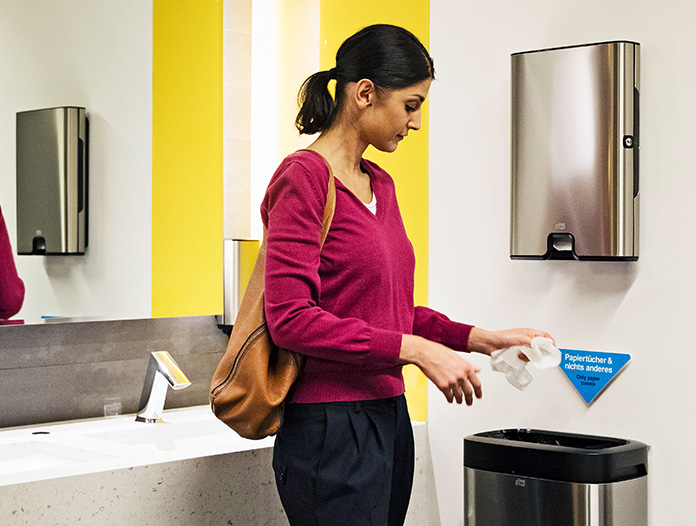Reduced environmental impact
Essity is acting to reduce its environmental impact across the value chain from the perspective of, for example, the climate, biodiversity and ecosystems, and also to increase recycling and reduce plastic waste.
Climate impact
As a global company in hygiene and health, Essity plays a leading role in driving change to reduce the company’s climate impact. In 2021, new and updated sustainability targets were adopted, that included a commitment to achieve net-zero emissions of greenhouse gases by 2050. We also raised our ambitions for existing Science Based Targets in the so-called Scope 1 and 2. Essity has a clear strategy and plan for how it will achieve these targets. The most important areas have been identified for the Science Based Targets 2030 and net-zero emissions by 2050. Action will be taken throughout the value chain, from raw materials, production, distribution to the management of used products. Our targets encompass both our own operations and our value chain, meaning Scope 1, 2 and 3.
Key action areas
Essity is focusing on the following areas to achieve our ambition of net-zero emissions.
- Sustainable solutions: We act to develop new and more sustainable products and services. Our offering now includes reusable menstruation and incontinence products. Through innovation, Essity has reduced the greenhouse gas footprint in the company’s different product categories by 10–30% over a ten-year period. Essity’s Group target is that at least 50% of the company’s innovations are to yield social and/or environmental improvements. In 2021, the outcome was 59%.
- Low carbon raw materials: Essity is striving to use more materials with lower greenhouse gas emissions. The largest share of greenhouse gas emissions from purchased raw materials is from fresh fiber and plastic used in our products and packaging. We collaborate with our suppliers to develop sustainable solutions with a focus on alternative, renewable and recycled materials, and encourage them to establish science-based targets and increase the use of renewable energy.
- Fossil fuel free production: In an industry that is traditionally energy intensive, one of our most important tasks to achieve net-zero emissions by 2050 is to become free from fossil fuels. To achieve this, measures include the increased use of hydrogen from renewable sources, biogas and geothermal steam.
- Resource efficiency: We have extensive experience of working with resource efficiency, including in our M-Save and E-Save programs that focus on material and energy efficiency, respectively. The reduction in CO2 emissions per ton produced between 2005 and 2021 was 19%.
- Breakthrough technology: In 2021, Essity began tissue manufacturing using pulp from wheat straw. Essity’s facility in Mannheim, Germany, is the world’s first facility in the tissue industry to use these agricultural by-products for large-scale production.
Sustainable innovations
Share that yielded social and/or environmental improvements
Target: >50%
Outcome:
Sustainable innovations are measured as the share of revenue from innovations launched in the most recent three years. Examples of sustainable innovations in 2021 included Tork cleaning cloths, TENA Silhouette washable absorbent underwear, and the Libresse menstrual cup.
Science Based Targets
Target 2030 (compared with 2016):
- Scope 1 and 2: Target: –35% Outcome 2021: –15%
- Scope 3: Target: –18% Outcome 2020: –9%
Memberships
Essity’s climate targets were approved by the Science Based Targets initiative in 2018 and, in 2021, Essity raised its ambitions for Scope 1 and 2. The climate targets are aligned with the ambitions of the Paris Agreement to reduce global warming. This climate initiative is supported by the CDP, WRI, WWF and UN Global Compact.
Essity has joined the UN Global Compact’s “Business Ambition for 1.5°C”, which includes an updated target in line with the scenario for “Well-under 2°C” and to develop targets to achieve net-zero emissions of greenhouse gases by 2050.
Essity has been a member of the UN Global Compact Action Platform on Climate Ambition since 2017. The platform provides an opportunity for collaboration between companies and important stakeholders to address the issues of limiting and adapting to climate change.

In 2021, Essity began tissue manufacturing using pulp from wheat straw at its production facility in Mannheim, Germany.
- Zero production waste: We act to make production waste a valuable resource and reduce our greenhouse gas emissions at the same time. The target for 2030 is that all production waste will be subject to material and energy recovery. In 2021, the total amount of production waste decreased, and 64% was recycled.
- Clean transport: When possible, we choose more sustainable modes of transport, such as sea and rail. By requesting highest emission standards we make use of the latest engine technology available. Essity also collaborates with partners to start pilot projects that involve the use of electric trucks and alternative fossil-free fuels to reduce transport emissions.
- Less waste after use: To reduce waste and create new uses for materials included in our products and packaging, we are developing innovative solutions to reduce consumption as well as new business models for recycling. For example, to reduce waste we offer compostable tissue products and the Tork PaperCircle recycling service has been expanded to ten markets. To address plastic recycling, Essity joined the HolyGrail 2.0 initiative in 2021, which uses a digital watermark to improve sorting and increase the recycling rate of plastic packaging in the EU.
To ensure that we meet the climate targets, Essity has appointed a steering committee led by members of the Executive Management Team. We are identifying the impact of climate change on Essity based on the TCFD framework, see more under Risk and risk management.
How we manufacture tissue
1) The main raw materials used to manufacture tissue are FSC and PEFC certified fresh fiber pulp and recovered paper. Manufacturing can also use alternative materials, such as pulp from wheat straw, and post-consumer waste, such as used paper hand towels, paper cups and food packaging.
2) Pulp is mixed with water in the paper machine and the paper is then dried.
3) The paper is wound into large reels, known as mother reels.
4) The mother reels are then converted into toilet rolls, household towels, napkins and handkerchiefs.
5) Our products create customer and consumer value and improve people’s well-being and quality of life.
Biodiversity and ecosystems
Essity respects biodiversity and ecosystems by promoting sustainable forestry operations, reducing greenhouse gas emissions and plastic waste, and improving water use and water quality. As part of a major analysis of our impact on biodiversity, biodiversity was integrated into Essity’s overall risk management in 2021.
Reduced material use and alternative materials
As a means of reducing wood fiber purchases, we strive to reduce material use in our solutions. We are investing in new technology to increase the possibility of utilizing a larger share of recycled and alternative materials. One step in this direction was Essity’s investment in the production facility in Hondouville, France, in 2021. The investment made it possible to increase the recycling capacity for cartons and extract 98% of paper fiber in food and beverage cartons. We are also investing in alternative renewable fibers such as wheat straw, an agricultural by-product that often remains unused.
Certification for sustainable forestry
Our long-standing work with responsible fiber sourcing is an important part of our sustainability strategy to support sustainable forestry and thereby promote biodiversity. We ensure sustainable fiber sourcing through certifications such as the Forest Stewardship Council (FSC) and the Programme for the Endorsement of Forest Certification (PEFC) and can therefore prevent deforestation and promote biodiversity in the forest. Every FSC-certified forest must be assessed by an accredited FSC certification body each year. Essity works with and encourages non-certified suppliers and forest owners to become certified. This secures our own sourcing of certified materials while increasing the availability of certified raw materials to other users. In order to further promote responsible forestry on global, regional and national levels, Essity is supporting the development of international certification systems.
Cooperation to combat forest degradation and deforestation
Essity cooperates within the framework of the Consumer Goods Forum (CGF) with leading consumer goods companies in the Forest Positive Coalition of Action initiative to combat global forest degradation and deforestation and to preserve biodiversity. In 2021, Essity took part in a project to strengthen sustainable forestry and care of forests with a high conservation value in north-western Russia, Europe’s largest connected forest area with high nature values. The purpose is to increase the uptake of sustainable forest management practices, as well as engage communities and other local stakeholders in a landscape planning process. In 2021, Essity played a leading role in CGF’s Forest Positive Coalition, where we worked with other global companies to strengthen forest management and prevent deforestation.
Targets and transparency
In 2021, Essity was awarded a place on the global non-profit environmental organization Carbon Disclosure Project’s (CDP) A List for its efforts in combating deforestation. This was motivated by Essity’s ambitious efforts to prevent deforestation and promote responsible forestry, and its leadership in terms of objectives, actions and transparency in the environmental field. Through CDP’s database, everyone can access information about how Essity works with fiber suppliers, industry organizations and other stakeholders, including non-profit organizations, to manage and promote sustainable forestry.

Improved water use and water quality
Around the world, declining water levels are affecting people, local economies and ecosystems. This also affects Essity’s operations, from access to raw materials and production facilities to the communities in which our employees and consumers live. The water risks differ around the world and we assess water-related risks and impacts individually for our production facilities, both from a geographic and operating perspective. Water is mainly needed for transporting fiber during the production process. Recirculating water that has been used in production several times helps to reduce energy use for heating and treatment of water. Most of the water is treated after use and is being discharged.
Environmental permits for tissue plants also include limits for typical pollutants, such as chemical oxygen demand, phosphorus and nitrogen. Essity is investing in new wastewater treatment technology to meet increasing requirements on the quality of the discharged water. This is particularly important in locations where water is a resource shared with a large number of users, such as along major rivers, where the temperature of the water released must also be carefully monitored.
Fresh fiber
Share of FSC or PEFC-certified fresh fiber
Target: 100%
Outcome:
Through certifications such as the Forest Stewardship Council (FSC) and the Programme for the Endorsement of Forest Certification (PEFC), Essity ensures sustainable fiber sourcing, thereby preventing deforestation and promoting biodiversity.
Memberships
Together with other companies and organizations in CGF’s Forest Positive Coalition of Action, Essity works systematically to address deforestation and forest destruction and promote biodiversity.
Essity is one of the world’s largest suppliers of FSC-certified hygiene and health products. We work with forest certification systems, such as FSC, which ensure sustainable forestry operations and respect for environmental, climate and social values.
In 2021, Essity was again awarded a place on CDP’s A List for its work in combating deforestation. CDP’s annual data collection and assessment process provides a benchmark for the transparency of companies’ environmental activities.

The Tork PaperCircle service collects used paper hand towels for reuse as new tissue products.
Recycling and less plastic use
To reduce waste arising from Essity’s production and after use, we are developing products and packaging containing less fossil-based plastic and more circular solutions.
Production waste
Resource efficiency and the reduction of waste are important in Essity’s production facilities and the target is that all production waste will be subject to material and energy recovery by 2030. Recycling or extracting energy from the waste instead of sending waste to landfill reduces greenhouse gas emissions. For example, recovered material from tissue manufacturing can be used as raw material for other industries, such as the construction industry.
Waste after use
Our services are constantly improving and new designs are utilized to reduce waste, and thereby cut greenhouse gas emissions. Essity aims to increase the use of renewable materials and new reusable products. We carry out circularity assessments as part of the innovation process to obtain a better understanding of how waste can be avoided after use. Examples include TENA SmartCare, where product use is optimized and waste reduced, and Tork PaperCircle, where used paper hand towels are collected and recycled to become new tissue products.
Most of our packaging is recyclable and we are working to optimize other packaging. We are reducing and replacing fossil-based plastic in our packaging and products with renewable or recovered materials. We are working to develop smarter designs and innovative plastic materials to reduce environmental impact.
Together with our suppliers, we are focusing on increasing the share of renewable and recovered plastic in our packaging. We also strive to broaden collaboration with our customers to further strengthen understanding of how their sustainability strategies and targets can be supported.
We are cooperating with customers, consumers, suppliers and other societal partners to identify more sustainable and circular solutions. A challenge in many markets is the lack of infrastructure for collecting used packaging or products. Essity therefore supports national initiatives for large-scale recycling of packaging.
Production waste
Subject to material or energy recovery
Target 2030: 100%
Outcome:
Resource efficiency and the reduction of waste are important in Essity’s production facilities. The target is that all production waste will be subject to material and energy recovery by 2030, which reduces greenhouse gas emissions.
Packaging
Share of packaging manufactured from renewable and/or recycled material
Target 2025: 85%
Outcome:
Essity is striving for 85% renewable and/or recycled material in the company’s packaging. This target applies to both paper and plastic packaging for Essity’s brands.
Packaging
Share of technically recyclable packaging1)
Target 2025: 100%
Outcome:
In 2021, Essity estimated the technical recyclability of a large portion of the company’s packaging. Essity has thereby improved packaging design to facilitate recycling using existing infrastructures.
Partnerships and collaboration
We are taking part in discussions with actors throughout the value chain to promote the implementation of waste systems that promote circularity, including the CGF, Edana, Ellen MacArthur Foundation and RecyClass. In 2021, Essity joined the Digital Watermarks Initiative HolyGrail 2.0, which is striving to introduce a digital watermark to improve sorting and to increase the recycling rate of plastic packaging in the EU. An invisible watermark on packaging helps waste sorting facilities to identify the type of plastic and sort it correctly.
Memberships
Essity’s membership of the Ellen MacArthur Foundation provides scope to share, learn and put into practice ideas for increased circularity, and to jointly pursue societal change. We are part of the New Plastic Economy initiative, which is aligned with and impacts external prerequisites for Essity’s target to ensure that all packaging is 100% recyclable and to increase the use of recovered plastic by 2025.
Through CGF’s Coalition of Action on Plastic Waste, Essity works together with customers, other companies and organizations to jointly reduce plastic waste and strive to improve social systems, so no plastic waste is disposed of in nature.
1) Packaging is recyclable using existing infrastructures.